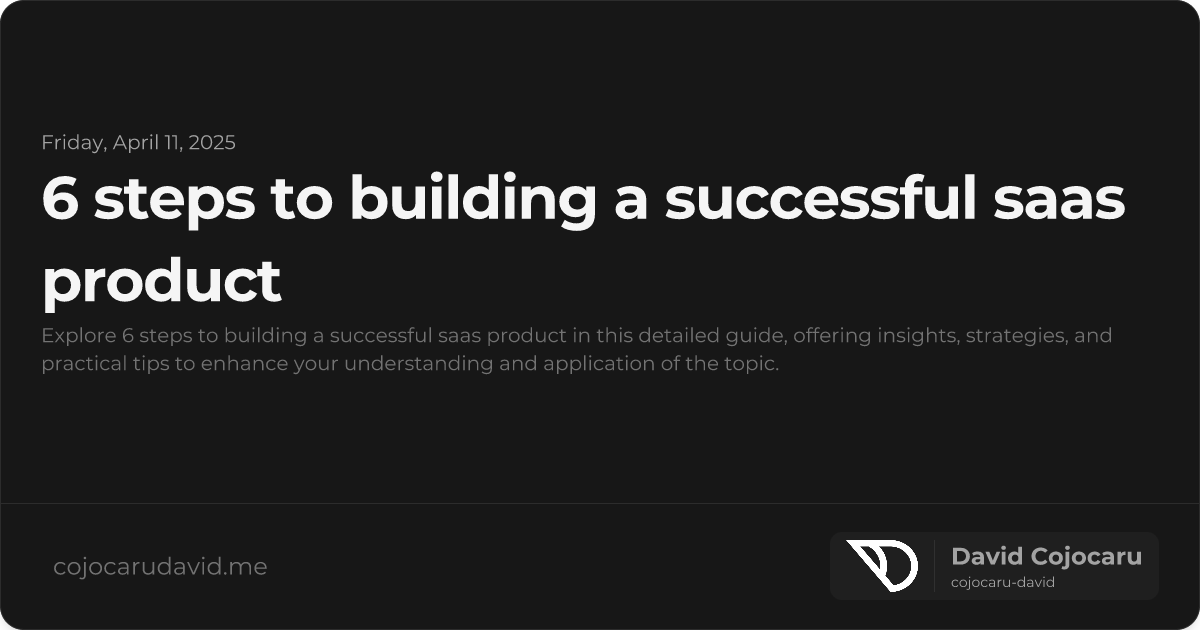6 Steps to Building a Successful SaaS Product: A Comprehensive Guide
Building a truly successful SaaS product requires more than just great code; it demands strategic planning, meticulous execution, and a relentless commitment to improvement. Whether you’re a seasoned developer or a first-time startup founder, understanding the core principles behind software-as-a-service success is crucial. This comprehensive guide breaks down the 6 essential steps to building a thriving SaaS product, from initial market validation to scaling your business for long-term growth.
Step 1: Validate Your Idea with Market Research
Before diving into development, you must confirm that your SaaS idea solves a genuine problem. This validation process is the cornerstone of a successful product.
- Conduct thorough market research: Analyze your competitors, identify emerging industry trends, and pinpoint customer pain points. Tools like Statista, Crunchbase, and Google Trends can provide valuable insights.
- Engage with your target audience: Directly solicit feedback from potential users through surveys, interviews, or early access beta programs. Understanding their needs firsthand is invaluable.
- Define your Unique Value Proposition (UVP): Clearly articulate what makes your SaaS product different and better than the competition. What specific benefits will users gain by choosing your solution?
Investing time in market research significantly reduces the risk of building a product that nobody needs or wants. It ensures you’re solving a real problem with a viable solution.
Step 2: Develop a Robust SaaS Product Strategy
A well-defined strategy ensures your SaaS product aligns with your overall business objectives and sets the stage for sustainable growth.
Define Your Business Model: Choose the Right Pricing
Selecting the appropriate pricing model is critical for revenue generation and customer acquisition. Common models include:
- Subscription-based (monthly/annual): Predictable revenue stream, often preferred by SaaS businesses.
- Freemium model (free tier + paid upgrades): Attracts a large user base, but requires careful tiering to incentivize upgrades.
- Usage-based pricing (pay-as-you-go): Appeals to users with fluctuating needs, offering flexibility and cost-effectiveness.
Select the Optimal Tech Stack: Build for Scalability
Choosing the right technologies from the outset will save you time and resources in the long run. Consider these options:
- Frontend: React, Vue.js, or Angular (for building interactive user interfaces)
- Backend: Node.js, Python (with Django or Flask), or Ruby on Rails (for handling server-side logic)
- Database: PostgreSQL, MongoDB, or MySQL (for storing and managing data)
- Cloud Hosting: AWS, Google Cloud Platform, or Microsoft Azure (for reliable and scalable infrastructure)
A well-planned tech stack not only ensures scalability and performance but also impacts development speed and maintainability.
Step 3: Build a Minimum Viable Product (MVP)
Resist the urge to build a fully featured product right away. Instead, focus on creating an MVP – a version with only the core functionality needed to solve the primary problem.
- Prioritize essential features: Focus on the features that deliver the most value to your target users.
- Keep the user interface simple and intuitive: Ease of use is crucial for early adoption.
- Collect user feedback early and often: Use this feedback to guide future development efforts.
An MVP allows you to validate your product’s core value proposition and gather valuable user feedback before investing heavily in additional features.
Step 4: Prioritize Security and Compliance
Security is paramount for any SaaS product, especially when handling sensitive user data.
- Implement strong encryption: Use SSL/TLS for data in transit and AES for data at rest.
- Ensure regulatory compliance: Adhere to relevant regulations such as GDPR, CCPA, or HIPAA, depending on your target market and the type of data you handle.
- Enable Multi-Factor Authentication (MFA): Protect user accounts with an extra layer of security.
A secure product builds trust with your users and mitigates the risk of costly data breaches and legal liabilities.
Step 5: Launch Strategically and Optimize for Growth
A successful launch requires a well-coordinated marketing effort, a seamless onboarding experience, and continuous performance tracking.
Implement Effective Marketing Strategies:
- Content marketing: Create valuable blog posts, case studies, and white papers to attract and educate your target audience.
- Paid advertising: Utilize platforms like Google Ads, LinkedIn Ads, and Facebook Ads to reach a wider audience.
- Search Engine Optimization (SEO): Optimize your website and content for relevant keywords to improve organic search visibility.
Onboard Users Effectively:
- Interactive tutorials and walkthroughs: Guide new users through the product’s key features.
- Email drip campaigns: Engage users with timely and relevant messages to encourage product adoption.
- Comprehensive customer support: Provide prompt and helpful assistance through chatbots, help documentation, and email support.
Track Key Performance Indicators (KPIs):
Monitor metrics like Monthly Recurring Revenue (MRR), churn rate, Customer Lifetime Value (LTV), and Customer Acquisition Cost (CAC) to measure the success of your launch and identify areas for improvement.
Step 6: Scale Intelligently and Iterate Continuously
Scaling a SaaS product is an ongoing process that requires continuous monitoring, analysis, and adaptation.
- Monitor analytics closely: Identify performance bottlenecks and areas where users are struggling.
- A/B test new features rigorously: Experiment with different versions of features to determine which performs best.
- Expand to new markets strategically: Research and target new geographic regions or customer segments as demand grows.
Regular updates, based on user feedback and data analysis, are essential for keeping users engaged, improving retention, and driving long-term growth.
Conclusion
Building a successful SaaS product is a challenging but rewarding journey. By following these 6 steps – validating your idea, developing a strategic plan, building an MVP, prioritizing security, optimizing for growth, and scaling intelligently – you can increase your chances of creating a product that meets the needs of your target audience, achieves sustainable growth, and stands out in a competitive market.
“The most successful SaaS products aren’t built in isolation. They’re constantly evolving based on user feedback, market trends, and a relentless pursuit of improvement.”
Now that you have the roadmap, it’s time to start building your SaaS success story!

